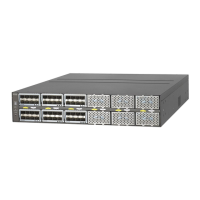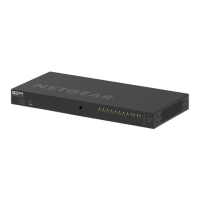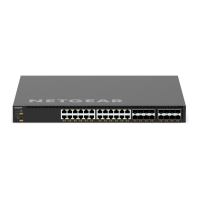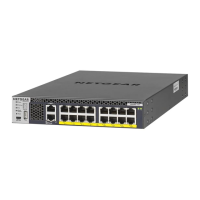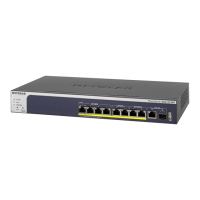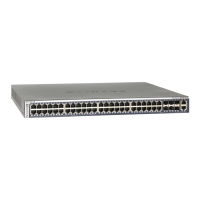Configure Quality of Service
241
M4100 Series Managed Switch
valid range is 0 to 100 in increments of 1. The value 0 means no guaranteed
minimum. The sum of individual Minimum Bandwidth values for all queues in the
selected interface cannot exceed the defined maximum (100).
• Use Scheduler Type to specify the type of scheduling used for this queue. Options
are Weighted and Strict. Defining on a per-queue basis allows the user to create the
desired service characteristics for different types of traffic.
• Weighted. Weighted round robin associates a weight to each queue. This is the
default.
• Strict. Services traffic with the highest priority on a queue first.
Queue Management Type displays the Queue depth management technique used for
queues on this interface. This is used only if the device supports independent settings
per-queue. Queue Management Type can only be tailDrop. All packets on a queue are
safe until congestion occurs. At this point, any additional packets queued are dropped.
10. Click the APPLY button.
Your changes are applied to the system.
Differentiated Services
The QoS feature contains Differentiated Services (DiffServ) support that allows traffic to be
classified into streams and given certain QoS treatment in accordance with defined per-hop
behaviors.
Standard IP-based networks are designed to provide best effort data delivery service. “Best
effort” service implies that the network delivers the data in a timely fashion, although this can
depend on the environment. During times of congestion, packets might be delayed, sent
sporadically, or dropped. For typical Internet applications, such as email and file transfer, a
slight degradation in service is acceptable and in many cases unnoticeable. Conversely, any
degradation of service has undesirable effects on applications with strict timing requirements,
such as voice or multimedia.
Defining DiffServ
To use DiffServ for QoS, you must first define the following categories and their criteria:
1. Class. Create classes and define class criteria.
2. Policy. Create policies, associate classes with policies, and define policy statements.
3. Service. Add a policy to an inbound interface.
Packets are classified and processed based on defined criteria. The classification criteria are
defined by a class. The processing is defined by a policy's attributes. Policy attributes can be
defined on a per-class instance basis, and it is these attributes that are applied when a match
occurs. A policy can contain multiples classes. When the policy is active, the actions taken
depend on which class matches the packet.
Packet processing begins by testing the class match criteria for a packet. A policy is applied
to a packet when a class match within that policy is found.
